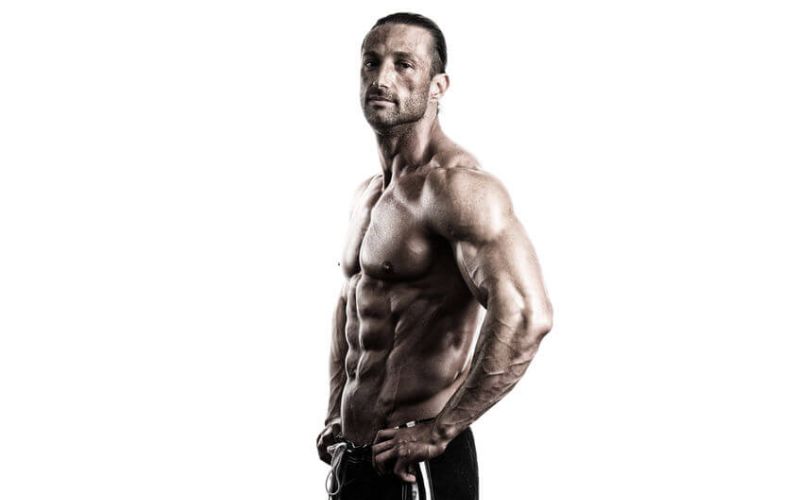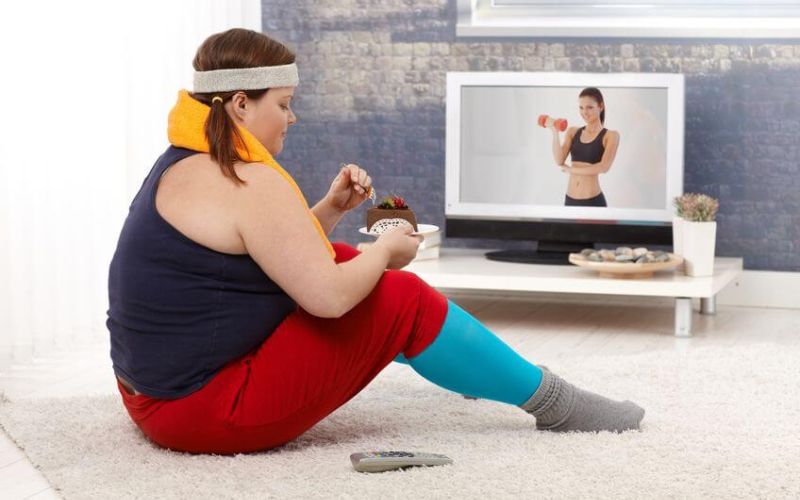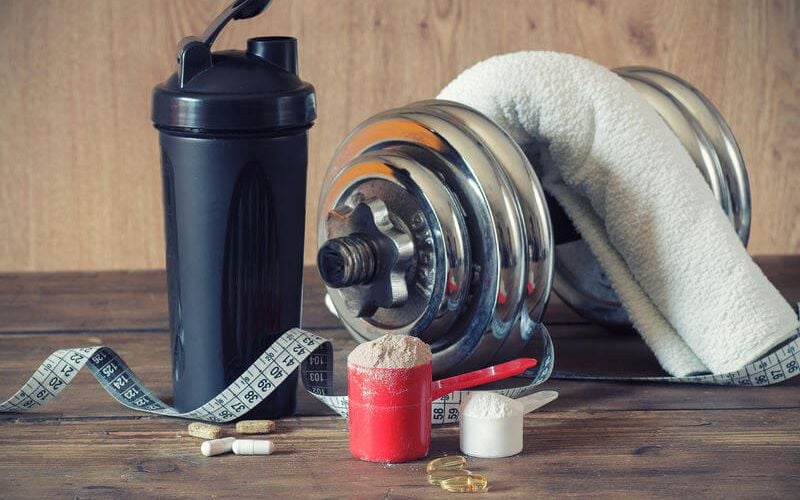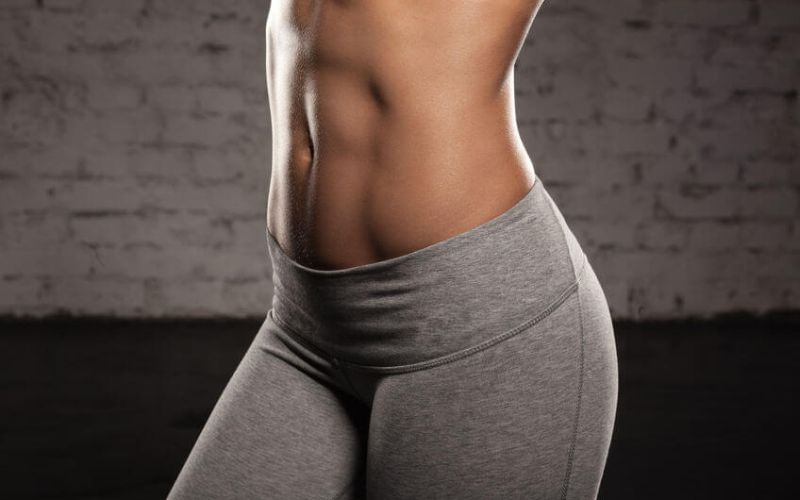Weight loss has rules.
Legit rules.
They’re mathematical in nature and we’re beholden to them whether we like it or not.
You can’t just break the rules because you don’t like them or because you hope they don’t apply to you. This is where many dieters fail.
A few of these principles relate to food intake and a few relate to what types of exercise you should do, which is what we’re going to focus on here.
There are many opinions on the subject, of course.
For example…
- Some people say cardio is the ultimate weight loss exercise. Others say it’s actually quite ineffective.
- Some people say weightlifting is for building muscle and not losing weight. End of story.
- Some people say certain exercises will help you lose fat in certain areas of your body. Some say otherwise.
Well, in this article, we’re going to get definitive answers to these controversies and more.
By the end, you’re going to know exactly what types of exercise are best for weight loss and why, and how to make losing weight as easy as possible.
I want to start by making an important distinction.
So far, we’ve been talking “weight loss.”
Instead, we need to focus on fat loss, and here’s why…
Table of Contents
+
Why You Don’t Want to Merely “Lose Weight”

What do millions of people resolve to do every January?
Lose weight, right?
That’s the wrong way of looking at it, though. What they really want to do is lose fat.
I’m not being pedantic, either–there’s a big difference between those two goals.
Strictly speaking, weight loss refers to reducing a number on a scale.
Well, you don’t know what you’re doing, you can lose plenty of weight…and wind up skinny fat.
If you want a simple demonstration of this, just follow one of the many popular weight loss diets and exercise programs that go something like this:
- Eat very little food.
- Pay no attention to macros.
- Do very little resistance training.
- Do egregious amounts of cardio.
You’ll lose plenty of weight…comprised of both muscle and fat.
And as you can guess, muscle loss is the major concern here because the more you lose, the worse you look, even with a relatively low body fat percentage.
This is how you ruin your body composition.
If you go about it differently, though, and focus on losing fat while preserving muscle, the upshot is very different.
You may lose less weight but you’ll be better for it because you’ll have retained (or even gained) muscle, which means you’ll be much happier with what you see in the mirror.
So, you came into this article wanting to know more about “weight loss.”
I want you to start thinking “fat (and not muscle) loss,” though, because that’s what I want for you.
The Best Exercises for Weight Loss Aren’t…

What kind of exercises do most people think they should do lose belly fat?
Ab exercises, of course.
What about thigh fat?
Squats are supposed to burn away that blight, aren’t they?
And so the list goes…
- Lunges for butt fat
- Rows for back fat
- Curls for biceps fat
- And on and on…
Well, these exercises don’t work like that. In fact, exercise in general doesn’t work like that.
Exercises burn calories, which aids in fat loss, and while research shows that training a muscle increases blood flow and lipolysis in the area, the effects are too small to matter.
That is, you can’t do crunches to get a six pack or hip thrusts to shrink your butt.
Ironically, if you want a certain area of your body to be leaner or “slimmer,” training the muscles without also reducing your body fat percentage will create the opposite effect.
It will simply end up looking bigger.
(This, by the way, is why many women mistakenly believe that weightlifting will make them “bulky.”)
The reason for this is fat loss is a whole-body process. You can’t selectively lose (or gain) fat in one region of your body or another.
Yes, all of us tend to store our fat differently, but the basic mechanism is the same–when we gain fat, we gain it everywhere, and when we lose it, we see a reduction in total-body fat mass.
What this means is you can use diet and exercise to get leaner, but some areas will lose inches faster than others.
(And unfortunately, the fat we want to lose the most is also usually the hardest to lose, but that’s another discussion.)
What Are the Best Exercises for Weight Loss, Then?

The best exercises for weight loss meet several criteria:
- They burn a significant amount of energy.
- They result in little to no muscle loss.
- They don’t place the body under too much stress.
By focusing on these types of exercises, you’ll lose fat (and not muscle) as quickly and “painlessly” as possible. You may even gain some muscle, too.
Now, what most people don’t know is the “secret” to getting ripped isn’t doing a handful of “special” exercises like air squats, planks, butt raises, or anything else.
It’s doing the right type of exercise.
(The truth is there is no “secret,” really, but some approaches certainly work better than others.)
In other words, it’s not so much about the individual exercises that you do as the style of exercise.
Let’s break this down.
Is Cardio the Best Type of Exercise to Lose Weight?

If you ask someone that wants to lose weight what they need to do, what will they say?
“Diet and exercise,” right?
And if you ask them what type of exercise, what will the likely answer be?
You know, walking, jogging, swimming, biking, and so forth.
Unfortunately, this guarantees little in the way of weight loss (even when you do quite a bit).
In fact, research shows that you can just wind up fatter as a result, mainly by negating its already meager weight loss benefits by unconsciously eating too much and/or reducing other forms of physical activity.
Hence the throngs of overweight people in your gym crowding the treadmills, wondering why they’re still not losing weight.
There are two reasons why your traditional cardio workout is a mediocre (at best) weight loss tool.
Cardio doesn’t burn all that much energy.
If you’re like most people, running vigorously for 30 minutes is pretty exhausting.
Guess how much energy it burns, though?
Anywhere from 400 to 600 calories, depending on your speed and body weight.
If that sounds like a lot to you, consider that it’s the amount of energy in…
- A handful of nuts, some yogurt, and an apple.
- A large blueberry muffin.
- A plain bagel with cream cheese
- A waffle with a drizzle of syrup
- 4 slices of bacon
- 4.5 ounces of cheese
The point isn’t that you shouldn’t eat nuts, muffins, or bacon when you want to lose weight, of course, but this:
Cardio workouts don’t burn as much energy as we wish they did, making it very easy to eat back all the calories burned (and more).
The same could be said of many other types of workouts as well, by the way.
This is why people that say you just need to “move more” to lose weight are missing the forest for the trees.
Increased physical activity can help, of course, but if you don’t know what you’re doing with your diet, no amount of exercise is going to be enough to keep the needle moving.
Your body “learns” to burn less energy.
You probably know that an energy deficit is required to lose fat.
(If not, read this article.)
And you probably know that in almost all cases, a “weight loss plateau” boils down to eating too much.
(If not, read this article.)
What you may not know, though, is when in a calorie deficit, your body works to diminish it through moving less and promoting overeating.
It does this because its goal is to maintain homeostasis. It doesn’t want to be in a calorie deficit.
One of these adaptations is an increase in energy efficiency.
The net effect of this is, over time, your body burns fewer and fewer calories doing the same workouts (it becomes more energy efficient in doing them).
This shrinks your calorie deficit, which slows down your weight loss.
When this happens, many people don’t understand what’s going on and try to fight fire with fire.
They resolve to “move more” (do more cardio) and while this increases energy expenditure (and thus fat loss), it can also accelerate muscle loss and metabolic slowdown.
They often reduce caloric intake to near-starvation levels as well, which only makes matters worse.
All this is why I generally recommend that people keep cardio to a minimum when dieting to lose fat.
Yes, you read that correctly.
If we’re just talking body composition, the less cardio you can do when cutting, the better.
What does all that mean specifically, though?
What qualifies as the “right” amount (and type) of cardio?
The Best Type of Cardio for Weight Loss

There are two types of cardio that I believe are best for losing weight:
1. High-intensity interval training (HIIT)
2. Walking
That probably sounds contradictory to you.
How could the hardest and easiest forms of cardio both be the “best” for fat loss?
Well, it’s precisely because of their opposite positions on the “exertion” spectrum.
Let me explain.
Why HIIT is Best for Rapid Fat Loss

High-intensity interval training, or HIIT for short, is a style of exercising where you alternate between periods of (almost) all-out and low effort.
Hence, the name.
The high-intensity intervals push your body toward its metabolic limits (basically as hard as you can go) and the low-intensity intervals allow it to recover (catching your breath).
HIIT is fantastic for weight loss because it burns a large amount of energy in a relatively short period of time (and has semi-significant “afterburn” effects as well).
A study conducted by scientists at The University of Western Ontario shows just how effective it really is.
Researchers had 10 men and 10 women train 3 times per week, with one group doing 4 to 6 30-second treadmill sprints (with 4 to 6 minutes of rest in between each), and the other group doing 30 to 60 minutes of steady-state cardio (jogging at about 65% of VO2 max).
The results?
After 6 weeks of training, the subjects doing the intervals had lost significantly more fat.
Yes, 4 to 6 30-second sprints burn more fat than 60 minutes of jogging.
This isn’t just better for your social life–it’s better for your muscles, too.
You see, research shows that cardio workouts can directly impair strength and muscle hypertrophy gains.
These effects are compounded and magnified when you’re in a calorie deficit, which is why doing too much cardio while cutting can cause a considerable amount of muscle loss.
Well, with HIIT, you can have the best of both worlds: relatively short workouts that burn a considerable amount of fat and minimally impact muscle.
So, if you’re sold on HIIT, you probably have a few questions, such as…
- How “intense” do the high-intensity intervals need to be in terms of exertion and length?
- How “restful” and long should the rest periods be?
- How long should the workouts be?
- How frequently should you do HIIT?
Basically: what actually qualifies as a HIIT workout and how do you get the most out of this type of training?
Read this article to find out.
Walking: The Easiest Way to Lose Fat Faster

When viewed in terms of fat burning, walking is no HIIT, but it deserves more attention than it gets.
You see, it’s not nearly as effective for maximizing fat loss, but it’s definitely the easiest way to increase energy expenditure and lose weight faster.
Case in point:
A study conducted by scientists at California State University with college-aged men and women found that subjects that ran a 10-minute mile burned about 190 calories.
Subjects that walked a 19-minute mile burned fewer calories, of course, but it’s not as few as you might think–about 111 calories.
If you walked a few hours per week, then, you could augment your energy expenditure by anywhere from 1,000 to 2,000 calories, which could translate to an additional 1 to 2 pounds of fat loss per month.
Not too shabby.
Research shows that this is enough to significantly reduce the risk of heart disease and all-cause mortality (death from any cause), as well.
Furthermore, studies show that walking can counteract the effects of stress and reduce cortisol levels.
This is significant because managing stress (and thus cortisol) levels is an important part of minimizing muscle loss while restricting calories to lose fat.
You do this primarily by managing how much you eat and exercise, and this is where many people go astray.
They eat far too little and exercise far too much, and this can cause a whole slew of problems ranging from depression to muscle loss to low energy to food cravings and more.
Well, walking is great in this regard because, unlike more intense forms of exercise, it places very little stress on the body.
That means that you can “safely” add several hours of weekly walking on top an already rigorous exercise schedule without risking overtraining.
Weightlifting: the Unsung Hero of Weight Loss

Most people mistakenly associate weightlifting with “bulking up” and not “slimming down.”
That’s probably because, as we discussed earlier, they’re too focused on weight as opposed to body composition.
You see, weightlifting isn’t a good way to lose weight because it causes muscle gain, which makes you heavier…but research shows that it’s an extremely effective way to speed up fat loss.
For example, let’s review a study conducted by scientists at Duke University.
196 men and women ranging from 18 to 70 years old were separated into three groups:
1. Resistance training (RT)
This group did three 60-minute resistance training workouts per week that consisted of 24 sets of machine exercises.
2. Aerobic training (AT)
This group jogged three days per week for about 45 minutes per workout.
3. Aerobic and resistance training (AT/RT)
This group did both of the workouts above, which summed up to about 5 hours of exercise per week.
Which group do you think lost the most weight?
Well, after eight months, scientists found at the aerobic training group topped the weight loss charts.
BUT!
They also lost the most muscle.
Guess who lost the most fat (and gained muscle to boot)?
You got it–the aerobic and resistance training group.
These “recomp” effects have been seen in several other studies as well.
The bottom line is this:
If you want to lose fat as quickly as possible while preserving or even building muscle, then you want to do both resistance and aerobic training.
What Type of Weightlifting Is Best for Weight Loss?

The weightlifting best for losing fat would do two things:
1. Burn a significant amount of energy without over-stressing the body.
2. Overload the muscles to stimulate muscle growth.
Well, there happens to be a weightlifting workout that fits that bill perfectly: One that emphasizes heavy compound lifting.
By “heavy,” I mean handling weights that are 70%+ of your one-rep max (and ideally closer to 80 to 85%).
The reason for this is simple: it burns a lot of energy.
A study published by scientists at Democritus University of Thrace (Greece) found that training with weights in the range of 80 to 85% of 1RM significantly increases metabolic rate over the following three days, burning hundreds more calories than training with lighter weights (45 to 65% of 1RM).
Similar effects were seen in a study conducted by researchers at Gama Filho University (Brazil) as well.
By “compound,” I mean focusing on compound exercises, which are those that train multiple major muscle groups (like the squat, deadlift, and bench and overhead press).
To nobody’s surprise, research shows that compound exercises burn more energy during and after training than isolation exercises (which isolate one major muscle group, like the biceps curl).
For example, just four heavy sets of deadlifts can burn over 100 calories, and that’s not taking into account the additional energy expenditure burned due to the “afterburn effect.”
As luck would have it, this style of weightlifting is also best for building muscle and strength, which serves our purposes perfectly.
That’s why thousands of people have used workout programs like mine to successfully build muscle and lose fat at the same time.
The “Best” Weight Loss Exercise Routine?

If you want to see all this in action, do the following:
- 3 to 5 1-hour heavy weightlifting sessions per week
If you need help creating a weightlifting routine, check out this article.
- 2 to 3 25-minute HIIT sessions per week
If you’re not sure how to best program your HIIT workouts, read this article.
- 2 to 3 30 to 45-minute walks per week
If you’d like to know a bit more about the benefits of walking, this article will help you.
If you do that and follow a proper meal plan, you will lose fat (and not muscle!) faster than you ever have before.
What About Supplements?

I saved this for last because, quite frankly, it’s far less important than everything else we’ve covered so far.
You see, supplements don’t build great physiques–dedication to proper training and nutrition does.
Unfortunately, the workout supplement industry is plagued by pseudoscience, ridiculous hype, misleading advertising and endorsements, products full of junk ingredients, underdosing key ingredients, and many other shenanigans.
Most supplement companies produce cheap, junk products and try to dazzle you with ridiculous marketing claims, high-profile (and very expensive) endorsements, pseudo-scientific babble, fancy-sounding proprietary blends, and flashy packaging.
So, while workout supplements don’t play a vital role in building muscle and losing fat, and many are a complete waste of money…the right ones can help.
The truth of the matter is there are safe, natural substances that have been scientifically proven to deliver benefits such as increased strength, muscle endurance and growth, fat loss, and more.
As a part of my work, it’s been my job to know what these substances are, and find products with them that I can use myself and recommend to others.
Finding high-quality, effective, and fairly priced products has always been a struggle, though.
That’s why I took matters into my own hands and decided to create my own supplements. And not just another line of “me too” supplements–the exact formulations I myself have always wanted and wished others would create.
I won’t go into a whole spiel here though. If you want to learn more about my supplement line, check this out.
For the purpose of this article, let’s just quickly review the supplements that are going to help you get the most out of your efforts to lose fat.
Caffeine
As weight loss boils down to energy consumed vs. energy expended, caffeine helps you lose fat by increasing your body’s daily energy expenditure.
Caffeine also improves strength, muscle endurance, and anaerobic performance, and also reverses the “morning weakness” experienced by many weightlifters.
Part of maximizing the fat loss benefits of caffeine is preventing your body from building up too much of a tolerance, however. The best way to do this is to limit intake, of course.
Here’s what I recommend:
- Before training, supplement with 3 – 6 mg caffeine per kg of body weight. If you’re not sure of your caffeine sensitivity, start with 3 mg/kg and work up from there.
- Keep your daily. intake at or below 6 mg per kg of body weight. Don’t have 6 mg/kg before training and then drink a couple of coffees throughout the day.
- Do 1 – 2 low-caffeine days per week, and 1 no-caffeine day per week. A low day should be half your normal intake, and a no day means less than 50 mg of caffeine (you can have a cup or two of tea, but no coffee, caffeine pills, etc.).
Personally I get my caffeine from my pre-workout PULSE, which contains a dehydrated and concentrated form of caffeine (caffeine anhydrous) shown to be more effective for improving performance than what is naturally found in beverages like coffee.
PULSE also contains clinically effective dosages of 5 other ingredients scientifically proven to improve workout performance:
- Beta-Alanine. Beta-alanine is a naturally occurring amino acid that reduces exercise-induced fatigue, improves anaerobic exercise capacity, and can accelerate muscle growth.
- Citrulline Malate. Citrulline is an amino acid that improves muscle endurance, relieves muscle soreness, and improves aerobic performance.
- Betaine. Betaine is a compound found in plants like beets that improves muscle endurance, increases strength, and increases human growth hormone and insulin-like growth factor 1 production in response to acute exercise.
- Ornithine. Ornithine is an amino acid found in high amounts in dairy and meat that reduces fatigue in prolonged exercise and promotes lipid oxidation (the burning of fat for energy as opposed to carbohydrate or glycogen).
- Theanine. Theanine is an amino acid found primarily in tea that reduces the effects of mental and physical stress, increases the production of nitric oxide, which improves blood flow, and improves alertness, focus, attention, memory, mental task performance, and mood.
And what you won’t find in PULSE is equally special:
- No artificial sweeteners or flavors.
- No artificial food dyes.
- No unnecessary fillers, carbohydrate powders, or junk ingredients.
The bottom line is if you want to know what a pre-workout is supposed to feel like…if you want to experience the type of energy rush and performance boost that only clinically effective dosages of scientifically validated ingredients can deliver…then you want to try PULSE.
Yohimbine
Yohimbine is made from the Pausinystalia yohimbe plant, and it helps the body “tap into” fat stores.
(Not a very technical explanation, I know–if you want to know exactly how it works, check out this article of mine on how to lose stubborn fat.)
Yohimbine accelerates weight loss, but only works if you’re training in a fasted state. Elevated insulin levels negate yohimbine’s effects.
I’ve cut both with and without fasted training and yohimbine and I can say with absolutely certainty that with is noticeably faster. So much so that I think the biggest benefits of fasted training are that it lets you use yohimbine and it makes the other supplements discussed in this article more effective.
By itself, fasted training will make a slight difference in how quickly you lose fat. Combined with these supplements, however, it’s quite dramatic.
In terms of dosages, research has shown that .2 mg/kg of body weight is sufficient for fat loss purposes, and that ingesting it prior to exercise is particularly effective.
Some people get overly jittery from yohimbine, so I recommend you start with .1 mg/kg of body weight to assess tolerance. If you feel fine, then increase to the clinically effective dosage of .2 mg/kg.
Furthermore, yohimbine can raise blood pressure. If you have high blood pressure, I don’t recommend you use it.
In terms of which specific yohimbine supplement I recommend, you’re probably not surprised that I’ve included a clinically effective dosage in every serving of my pre-workout fat burner FORGE.
FORGE is a fat burner made specifically for use with fasted training and it contains clinically effective dosages of…
- HMB. β-Hydroxy β-Methylbutyrate (also known as HMB) is a substance formed when your body metabolizes the amino acid leucine.
Research shows that HMB is an extremely effective anti-catabolic agent, which means it’s very good at preventing muscle breakdown. And this means you will recover faster from your workouts and experience less muscle soreness.
- Yohimbine. Research shows that yohimbine enables your body to reduce fat stores faster, and it’s particularly useful as you get leaner and are battling with stubborn fat holdouts.
- Citicoline. CDP-choline (also known as citicoline) is a chemical that occurs naturally in the brain that increases levels of another chemical called phosphatidylcholine, which is vital for brain function.
Research shows that supplementation with CDP-choline improves attentional focus, and I included this in FORGE because most people find fasted training more mentally draining than fed training and CDP-choline can help counteract this.
The bottom line is FORGE helps you lose fat–and “stubborn” fat in particular–faster, preserve muscle, and maintain training intensity and mental sharpness.
PHOENIX Fat Burner
With the weight loss market valued at a staggering $60.5 billion and more than one-third of U.S. adults obese, it’s no surprise that there’s a glut of “fat burners” for sale these days.
And for the same reasons it’s also no surprise that fat burners are some of the most expensive supplements on the shelves and feature some of the loudest marketing claims, often making big promises of “scientifically proven” rapid fat loss.
The reality is most “fat burners” are junk but there are a handful of natural, safe substances that have been scientifically proven to accelerate fat loss. And that’s why I created PHOENIX.
PHOENIX’s caffeine-free formulation is helps you burn fat faster in three different ways:
- It dramatically increases metabolic speed.
- It amplifies the power of fat-burning chemicals produced by your body.
- It increases the feeling of fullness from food.
It accomplishes this through clinically effective dosages of several ingredients, including…
- Synephrine. This increases both basal metabolic rate and lipolysis, inhibits the activity of certain fat cell receptors that prevent fat mobilization, and increases the thermic effect of food (the “energy cost” of metabolizing food).
- Naringin. This stimulates the production of a hormone called adiponectin, which is involved in the breakdown of fat cells, and that it activates a type of receptor in fat cells that regulates fat mobilization (the PPARα receptor).
Through these mechanisms, naringin also works synergistically with synephrine and hesperidin to further accelerate the basal metabolic rate.
- Hesperidin. Like naringin, this also stimulates the production of adiponectin and activates the PPARa receptor. It also improves blood flow and reduces the inflammation of blood vessels.
- Epigallocatechin gallate (EGCG). This inhibits the activity of a different enzyme also responsible for breaking down neurotransmitters that induce lipolysis. It has also been shown to reduce abdominal fat in particular.
- Forskolin. This increases blood plasma and intracellular levels of a molecule known as cAMP. When cAMP is high, it signifies a lack of ATP (the most basic form of cellular energy in the body) and thus initiates a process to make more ATP by burning through energy reserves (body fat).
Research has show that supplementation with forskolin accelerates fat loss and increases testosterone levels.
- And more…
The bottom line is if you want to lose fat faster without pumping yourself full of stimulants or other potentially harmful chemicals…then you want to try PHOENIX.
The Bottom Line on the Best Exercises to Lose Weight

We’ve covered a lot in this article, so here’s a quick summary:
- Focus on losing fat, not just weight.
- Don’t starve yourself and don’t eat too little protein.
- You can’t use certain exercises to lose fat in certain areas of your body (spot reduce).
- You don’t have to do much cardio.
- HIIT cardio is best for maximizing fat loss and walking is best for minimizing stress.
- Resistance training is very important for maximizing fat loss and preserving muscle.
- Heavy compound lifting gives you the best of both worlds (fat loss and muscle gain).
Make that your mantra and I promise you’ll get better results in the gym than you ever have before.
What’s your take on the best exercises for weight loss? Have anything else to share? Let me know in the comments below!
Scientific References +
- Jagtap, M., Ravishankar, B., & Chandola, H. (2011). Clinical efficacy of Coleus forskohlii (Willd.) Briq. (Makandi) in hypertension of geriatric population. AYU (An International Quarterly Journal of Research in Ayurveda), 32(1), 59. https://doi.org/10.4103/0974-8520.85729
- Godard, M. P., Johnson, B. A., & Richmond, S. R. (2005). Body composition and hormonal adaptations associated with forskolin consumption in overweight and obese men. Obesity Research, 13(8), 1335–1343. https://doi.org/10.1038/oby.2005.162
- Walsh, D. A., & Van Patten, S. M. (1994). Multiple pathway signal tran sduction by the cAMP‐dependent protein kinase. The FASEB Journal, 8(15), 1227–1236. https://doi.org/10.1096/fasebj.8.15.8001734
- Maki, K. C., Reeves, M. S., Farmer, M., Yasunaga, K., Matsuo, N., Katsuragi, Y., Komikado, M., Tokimitsu, I., Wilder, D., Jones, F., Blumberg, J. B., & Cartwright, Y. (2009). Green tea catechin consumption enhances exercise-induced abdominal fat loss in overweight and obese adults. Journal of Nutrition, 139(2), 264–270. https://doi.org/10.3945/jn.108.098293
- Zhu, B. T., Shim, J. Y., Nagai, M., & Bai, H. W. (2008). Molecular modelling study of the mechanism of high-potency inhibition of human catechol-O-methyltransferase by (-)-epigallocatechin-3-O-gallate. Xenobiotica, 38(2), 130–146. https://doi.org/10.1080/00498250701744641
- Rizza, S., Muniyappa, R., Iantorno, M., Kim, J. A., Chen, H., Pullikotil, P., Senese, N., Tesauro, M., Lauro, D., Cardillo, C., & Quon, M. J. (2011). Citrus polyphenol hesperidin stimulates production of nitric oxide in endothelial cells while improving endothelial function and reducing inflammatory markers in patients with metabolic syndrome. Journal of Clinical Endocrinology and Metabolism, 96(5). https://doi.org/10.1210/jc.2010-2879
- Stohs, S. J., Preuss, H. G., Keith, S. C., Keith, P. L., Miller, H., & Kaats, G. R. (2011). Effects of p-synephrine alone and in combination with selected bioflavo-noids on resting metabolism, blood pressure, heart rate and self-reported mood changes. International Journal of Medical Sciences, 8(4), 295–301. https://doi.org/10.7150/ijms.8.295
- Liu, L., Shan, S., Zhang, K., Ning, Z. Q., Lu, X. P., & Cheng, Y. Y. (2008). Naringenin and hesperetin, two flavonoids derived from Citrus aurantium up-regulate transcription of adiponectin. Phytotherapy Research, 22(10), 1400–1403. https://doi.org/10.1002/ptr.2504
- Gougeon, R., Harrigan, K., Tremblay, J. F., Hedrei, P., Lamarche, M., & Morais, J. A. (2005). Increase in the thermic effect of food in women by adrenergic amines extracted from citrus aurantium. Obesity Research, 13(7), 1187–1194. https://doi.org/10.1038/oby.2005.141
- Brown, C. M., McGrath, J. C., Midgley, J. M., Muir, A. G. B., O’Brien, J. W., Thonoor, C. M., Williams, C. M., & Wilson, V. G. (1988). Activities of octopamine and synephrine stereoisomers on α‐adrenoceptors. British Journal of Pharmacology, 93(2), 417–429. https://doi.org/10.1111/j.1476-5381.1988.tb11449.x
- Haaz, S., Fontaine, K. R., Cutter, G., Limdi, N., Perumean-Chaney, S., & Allison, D. B. (2006). Citrus aurantium and synephrine alkaloids in the treatment of overweight and obesity: An update. In Obesity Reviews (Vol. 7, Issue 1, pp. 79–88). Obes Rev. https://doi.org/10.1111/j.1467-789X.2006.00195.x
- McGlade, E., Locatelli, A., Hardy, J., Kamiya, T., Morita, M., Morishita, K., Sugimura, Y., & Yurgelun-Todd, D. (2012). Improved Attentional Performance Following Citicoline Administration in Healthy Adult Women. Food and Nutrition Sciences, 03(06), 769–773. https://doi.org/10.4236/fns.2012.36103
- Millan, M. J., Newman-Tancredi, A., Audinot, V., Cussac, D., Lejeune, F., Nicolas, J. P., Cogé, F., Galizzi, J. P., Boutin, J. A., Rivet, J. M., Dekeyne, A., & Gobert, A. (2000). Agonist and antagonist actions of yohimbine as compared to fluparoxan at α2-adrenergic receptors (AR)s, serotonin (5-HT)(1A), 5-HT(1B), 5-HT(1D) and dopamine D2 and D3 receptors. Significance for the modulation of frontocortical monoaminergic transmission and depressive states. Synapse, 35(2), 79–95. https://doi.org/10.1002/(SICI)1098-2396(200002)35:2<79::AID-SYN1>3.0.CO;2-X
- Wilson, J. M., Lowery, R. P., Joy, J. M., Walters, J. A., Baier, S. M., Fuller, J. C., Stout, J. R., Norton, L. E., Sikorski, E. M., Wilson, S. M. C., Duncan, N. M., Zanchi, N. E., & Rathmacher, J. (2013). β-Hydroxy-β-methylbutyrate free acid reduces markers of exercise-induced muscle damage and improves recovery in resistance-trained men. British Journal of Nutrition, 110(3), 538–544. https://doi.org/10.1017/S0007114512005387
- Goldberg, M. R., Hollister, A. S., & Robertson, D. (1983). Influence of yohimbine on blood pressure, autonomic reflexes, and plasma catecholamines in humans. Hypertension, 5(5), 772–778. https://doi.org/10.1161/01.HYP.5.5.772
- McCarty, M. F. (2002). Pre-exercise administration of yohimbine may enhance the efficacy of exercise training as a fat loss strategy by boosting lipolysis. Medical Hypotheses, 58(6), 491–495. https://doi.org/10.1054/mehy.2001.1459
- GALITZKY, J., TAOUIS, M., BERLAN, M., RIVIÈRE, D., GARRIGUES, M., & LAFONTAN, M. (1988). α2‐Antagonist compounds and lipid mobilization: evidence for a lipid mobilizing effect of oral yohimbine in healthy male volunteers. European Journal of Clinical Investigation, 18(6), 587–594. https://doi.org/10.1111/j.1365-2362.1988.tb01272.x
- Ostojic, S. M. (2006). Yohimbine: The effects on body composition and exercise performance in soccer players. Research in Sports Medicine, 14(4), 289–299. https://doi.org/10.1080/15438620600987106
- Millan, M. J., Newman-Tancredi, A., Audinot, V., Cussac, D., Lejeune, F., Nicolas, J. P., Cogé, F., Galizzi, J. P., Boutin, J. A., Rivet, J. M., Dekeyne, A., & Gobert, A. (2000). Agonist and antagonist actions of yohimbine as compared to fluparoxan at α2-adrenergic receptors (AR)s, serotonin (5-HT)(1A), 5-HT(1B), 5-HT(1D) and dopamine D2 and D3 receptors. Significance for the modulation of frontocortical monoaminergic transmission and depressive states. Synapse, 35(2), 79–95. https://doi.org/10.1002/(SICI)1098-2396(200002)35:2<79::AID-SYN1>3.0.CO;2-X
- Haskell, C. F., Kennedy, D. O., Milne, A. L., Wesnes, K. A., & Scholey, A. B. (2008). The effects of l-theanine, caffeine and their combination on cognition and mood. Biological Psychology, 77(2), 113–122. https://doi.org/10.1016/j.biopsycho.2007.09.008
- Gomez-Ramirez, M., Kelly, S. P., Montesi, J. L., & Foxe, J. J. (2009). The effects of l-theanine on alpha-band oscillatory brain activity during a visuo-spatial attention task. Brain Topography, 22(1), 44–51. https://doi.org/10.1007/s10548-008-0068-z
- Foxe, J. J., Morie, K. P., Laud, P. J., Rowson, M. J., De Bruin, E. A., & Kelly, S. P. (2012). Assessing the effects of caffeine and theanine on the maintenance of vigilance during a sustained attention task. Neuropharmacology, 62(7), 2320–2327. https://doi.org/10.1016/j.neuropharm.2012.01.020
- Bryan, J. (2008). Psychological effects of dietary components of tea: Caffeine and L-theanine. In Nutrition Reviews (Vol. 66, Issue 2, pp. 82–90). Nutr Rev. https://doi.org/10.1111/j.1753-4887.2007.00011.x
- Siamwala, J. H., Dias, P. M., Majumder, S., Joshi, M. K., Sinkar, V. P., Banerjee, G., & Chatterjee, S. (2013). L-Theanine promotes nitric oxide production in endothelial cells through eNOS phosphorylation. Journal of Nutritional Biochemistry, 24(3), 595–605. https://doi.org/10.1016/j.jnutbio.2012.02.016
- Kimura, K., Ozeki, M., Juneja, L. R., & Ohira, H. (2007). l-Theanine reduces psychological and physiological stress responses. Biological Psychology, 74(1), 39–45. https://doi.org/10.1016/j.biopsycho.2006.06.006
- Sugino, T., Shirai, T., Kajimoto, Y., & Kajimoto, O. (2008). l-Ornithine supplementation attenuates physical fatigue in healthy volunteers by modulating lipid and amino acid metabolism. Nutrition Research, 28(11), 738–743. https://doi.org/10.1016/j.nutres.2008.08.008
- Apicella, J. M., Lee, E. C., Bailey, B. L., Saenz, C., Anderson, J. M., Craig, S. A. S., Kraemer, W. J., Volek, J. S., & Maresh, C. M. (2013). Betaine supplementation enhances anabolic endocrine and Akt signaling in response to acute bouts of exercise. European Journal of Applied Physiology, 113(3), 793–802. https://doi.org/10.1007/s00421-012-2492-8
- Lee, E. C., Maresh, C. M., Kraemer, W. J., Yamamoto, L. M., Hatfield, D. L., Bailey, B. L., Armstrong, L. E., Volek, J. S., McDermott, B. P., & Craig, S. A. S. (2010). Ergogenic effects of betaine supplementation on strength and power performance. Journal of the International Society of Sports Nutrition, 7. https://doi.org/10.1186/1550-2783-7-27
- Trepanowski, J. F., Farney, T. M., McCarthy, C. G., Schilling, B. K., Craig, S. A., & Bloomer, R. J. (2011). The effects of chronic betaine supplementation on exercise performance, skeletal muscle oxygen saturation, and associated biochemical parameters in resistance trained men. Journal of Strength and Conditioning Research, 25(12), 3461–3471. https://doi.org/10.1519/JSC.0b013e318217d48d
- Bendahan, D., Mattei, J. P., Ghattas, B., Confort-Gouny, S., Le Guern, M. E., & Cozzone, P. J. (2002). Citrulline/malate promotes aerobic energy production in human exercising muscle. British Journal of Sports Medicine, 36(4), 282–289. https://doi.org/10.1136/bjsm.36.4.282
- Pérez-Guisado, J., & Jakeman, P. M. (2010). Citrulline malate enhances athletic anaerobic performance and relieves muscle soreness. Journal of Strength and Conditioning Research, 24(5), 1215–1222. https://doi.org/10.1519/JSC.0b013e3181cb28e0
- Kern, B. D., & Robinson, T. L. (2011). Effects of β-alanine supplementation on performance and body composition in collegiate wrestlers and football players. Journal of Strength and Conditioning Research, 25(7), 1804–1815. https://doi.org/10.1519/JSC.0b013e3181e741cf
- Smith, A. E., Walter, A. A., Graef, J. L., Kendall, K. L., Moon, J. R., Lockwood, C. M., Fukuda, D. H., Beck, T. W., Cramer, J. T., & Stout, J. R. (2009). Effects of β-alanine supplementation and high-intensity interval training on endurance performance and body composition in men; a double-blind trial. Journal of the International Society of Sports Nutrition, 6. https://doi.org/10.1186/1550-2783-6-5
- Derave, W., Özdemir, M. S., Harris, R. C., Pottier, A., Reyngoudt, H., Koppo, K., Wise, J. A., & Achten, E. (2007). β-Alanine supplementation augments muscle carnosine content and attenuates fatigue during repeated isokinetic contraction bouts in trained sprinters. Journal of Applied Physiology, 103(5), 1736–1743. https://doi.org/10.1152/japplphysiol.00397.2007
- Goldstein, E. R., Ziegenfuss, T., Kalman, D., Kreider, R., Campbell, B., Wilborn, C., Taylor, L., Willoughby, D., Stout, J., Graves, B. S., Wildman, R., Ivy, J. L., Spano, M., Smith, A. E., & Antonio, J. (2010). International society of sports nutrition position stand: Caffeine and performance. In Journal of the International Society of Sports Nutrition (Vol. 7, Issue 1). J Int Soc Sports Nutr. https://doi.org/10.1186/1550-2783-7-5
- Mora-Rodríguez, R., Pallarés, J. G., López-Samanes, Á., Ortega, J. F., & Fernández-Elías, V. E. (2012). Caffeine ingestion reverses the circadian rhythm effects on neuromuscular performance in highly resistance-trained men. PLoS ONE, 7(4). https://doi.org/10.1371/journal.pone.0033807
- Beck, T. W., Housh, T. J., Schmidt, R. J., Johnson, G. O., Housh, D. J., Coburn, J. W., & Malek, M. H. (2006). The acute effects of a caffeine-containing supplement on strength, muscular endurance, and anaerobic capabilities. Journal of Strength and Conditioning Research, 20(3), 506–510. https://doi.org/10.1519/18285.1
- Astorino, T. A., Rohmann, R. L., & Firth, K. (2008). Effect of caffeine ingestion on one-repetition maximum muscular strength. European Journal of Applied Physiology, 102(2), 127–132. https://doi.org/10.1007/s00421-007-0557-x
- Astrup, A., Toubro, S., Cannon, S., Hein, P., Breum, L., & Madsen, J. (1990). Caffeine: A double-blind, placebo-controlled study of its thermogenic, metabolic, and cardiovascular effects in healthy volunteers. American Journal of Clinical Nutrition, 51(5), 759–767. https://doi.org/10.1093/ajcn/51.5.759
- Brown, S. P., Clemons, J. M., He, Q., & Liu, S. (1994). Prediction of the oxygen cost of the deadlift exercise. Journal of Sports Sciences, 12(4), 371–375. https://doi.org/10.1080/02640419408732183
- Farinatti, P. T. V., & Castinheiras Net, A. G. (2011). The effect of between-set rest intervals on the oxygen uptake during and after resistance exercise sessions performed with large-and small-muscle mass. Journal of Strength and Conditioning Research, 25(11), 3181–3190. https://doi.org/10.1519/JSC.0b013e318212e415
- Meirelles, C. de M., & Gomes, P. S. C. (2004). Efeitos agudos da atividade contra-resistência sobre o gasto energético: revisitando o impacto das principais variáveis. Revista Brasileira de Medicina Do Esporte, 10(2), 122–130. https://doi.org/10.1590/s1517-86922004000200006
- Fatouros, I. G., Chatzinikolaou, A., Tournis, S., Nikolaidis, M. G., Jamurtas, A. Z., Douroudos, I. I., Papassotiriou, I., Thomakos, P. M., Taxildaris, K., Mastorakos, G., & Mitrakou, A. (2009). Intensity of resistance exercise determines adipokine and resting energy expenditure responses in overweight elderly individuals. Diabetes Care, 32(12), 2161–2167. https://doi.org/10.2337/dc08-1994
- Donges, C. E., & Duffield, R. (2012). Effects of resistance or aerobic exercise training on total and regional body composition in sedentary overweight middle-aged adults. Applied Physiology, Nutrition and Metabolism, 37(3), 499–509. https://doi.org/10.1139/H2012-006
- Ho, S. S., Dhaliwal, S. S., Hills, A. P., & Pal, S. (2012). The effect of 12 weeks of aerobic, resistance or combination exercise training on cardiovascular risk factors in the overweight and obese in a randomized trial. BMC Public Health, 12(1). https://doi.org/10.1186/1471-2458-12-704
- Schwingshackl, L., Dias, S., Strasser, B., & Hoffmann, G. (2013). Impact of different training modalities on anthropometric and metabolic characteristics in overweight/obese subjects: A systematic review and network meta-analysis. In PLoS ONE (Vol. 8, Issue 12). PLoS One. https://doi.org/10.1371/journal.pone.0082853
- Willis, L. H., Slentz, C. A., Bateman, L. A., Shields, A. T., Piner, L. W., Bales, C. W., Houmard, J. A., & Kraus, W. E. (2012). Effects of aerobic and/or resistance training on body mass and fat mass in overweight or obese adults. Journal of Applied Physiology, 113(12), 1831–1837. https://doi.org/10.1152/japplphysiol.01370.2011
- Geliebter, A., Maher, M. M., Gerace, L., Gutin, B., Heymsfield, S. B., & Hashim, S. A. (1997). Effects of strength or aerobic training on body composition, resting metabolic rate, and peak oxygen consumption in obese dieting subjects. American Journal of Clinical Nutrition, 66(3), 557–563. https://doi.org/10.1093/ajcn/66.3.557
- Park, B. J., Tsunetsugu, Y., Kasetani, T., Kagawa, T., & Miyazaki, Y. (2010). The physiological effects of Shinrin-yoku (taking in the forest atmosphere or forest bathing): Evidence from field experiments in 24 forests across Japan. In Environmental Health and Preventive Medicine (Vol. 15, Issue 1, pp. 18–26). Environ Health Prev Med. https://doi.org/10.1007/s12199-009-0086-9
- Wilkin, L. D., Cheryl, A., & Haddock, B. L. (2012). Energy expenditure comparison between walking and running in average fitness individuals. In Journal of Strength and Conditioning Research (Vol. 26, Issue 4, pp. 1039–1044). J Strength Cond Res. https://doi.org/10.1519/JSC.0b013e31822e592c
- Willis, L. H., Slentz, C. A., Bateman, L. A., Shields, A. T., Piner, L. W., Bales, C. W., Houmard, J. A., & Kraus, W. E. (2012). Effects of aerobic and/or resistance training on body mass and fat mass in overweight or obese adults. Journal of Applied Physiology, 113(12), 1831–1837. https://doi.org/10.1152/japplphysiol.01370.2011
- Wilson, J. M., Marin, P. J., Rhea, M. R., Wilson, S. M. C., Loenneke, J. P., & Anderson, J. C. (2012). Concurrent training: A meta-analysis examining interference of aerobic and resistance exercises. Journal of Strength and Conditioning Research, 26(8), 2293–2307. https://doi.org/10.1519/JSC.0b013e31823a3e2d
- MacPherson, R. E. K., Hazell, T. J., Olver, T. D., Paterson, D. H., & Lemon, P. W. R. (2011). Run sprint interval training improves aerobic performance but not maximal cardiac output. Medicine and Science in Sports and Exercise, 43(1), 115–122. https://doi.org/10.1249/MSS.0b013e3181e5eacd
- Thomas, D. M., Bouchard, C., Church, T., Slentz, C., Kraus, W. E., Redman, L. M., Martin, C. K., Silva, A. M., Vossen, M., Westerterp, K., & Heymsfield, S. B. (2012). Why do individuals not lose more weight from an exercise intervention at a defined dose? an energy balance analysis. Obesity Reviews, 13(10), 835–847. https://doi.org/10.1111/j.1467-789X.2012.01012.x
- Keesey, R. E., & Powley, T. L. (2008). Body energy homeostasis. In Appetite (Vol. 51, Issue 3, pp. 442–445). NIH Public Access. https://doi.org/10.1016/j.appet.2008.06.009
- Melanson, E. L., Keadle, S. K., Donnelly, J. E., Braun, B., & King, N. A. (2013). Resistance to exercise-induced weight loss: Compensatory behavioral adaptations. Medicine and Science in Sports and Exercise, 45(8), 1600–1609. https://doi.org/10.1249/MSS.0b013e31828ba942
- Sawyer, B. J., Bhammar, D. M., Angadi, S. S., Ryan, D. M., Ryder, J. R., Sussman, E. J., Bertmann, F. M. W., & Gaesser, G. A. (2015). Predictors of fat mass changes in response to aerobic exercise training in women. Journal of Strength and Conditioning Research, 29(2), 297–304. https://doi.org/10.1519/JSC.0000000000000726
- Vispute, S. S., Smith, J. D., Lecheminant, J. D., & Hurley, K. S. (2011). The effect of abdominal exercise on abdominal fat. Journal of Strength and Conditioning Research, 25(9), 2559–2564. https://doi.org/10.1519/JSC.0b013e3181fb4a46
- Stallknecht, B., Dela, F., & Helge, J. W. (2007). Are blood flow and lipolysis in subcutaneous adipose tissue influenced by contractions in adjacent muscles in humans? American Journal of Physiology - Endocrinology and Metabolism, 292(2). https://doi.org/10.1152/ajpendo.00215.2006










